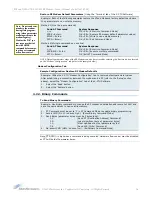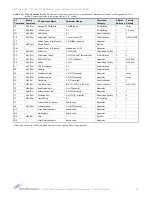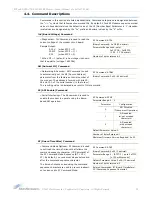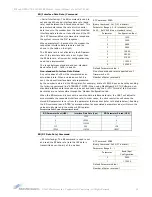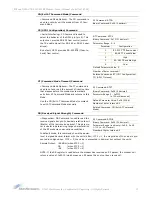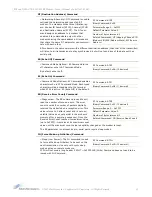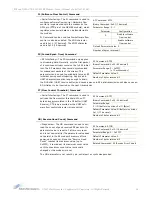
9XTend
‐
NEMA™
RS
‐
232/485
RF
Modem
–
Product
Manual
v2.x4x
[2007.01.04]
©
2007
MaxStream,
Inc.,
Confidential
&
Proprietary
‐
All
Rights
Reserved
20
3.2.4. Sleep Mode
Software Sleep
Sleep Modes enable the modem to enter states of low-power consumption when not in use. Three
software Sleep Modes are supported:
• Pin Sleep (Host Controlled)
• Serial Port Sleep (Wake on Serial Port activity)
• Cyclic Sleep (Wake on RF activity)
In order to enter Sleep Mode, one of the following conditions must be met (in addition to the
modem having a non-zero SM parameter value):
When in Sleep Mode, the modem will not transmit or receive data until the modem first transitions
to Idle Mode. All Sleep Modes are enabled and disabled using SM Command. Transitions into and
out of Sleep Modes are triggered by various mechanisms as shown in the table below.
The SM (Sleep Mode) command is central to setting all Sleep Mode configurations. By default,
Sleep Modes are disabled (SM = 0) and the modem remains in Idle/Receive Mode. When in this
state, the modem remains constantly ready to respond to serial or RF activity.
Pin Sleep (SM = 1)
• Pin/Host-controlled
• Typical power-down current: < 17 mA
This mode is voltage level activated. When the GPI2 pin is asserted, the modem will finish any
transmitting or receiving activity; enter Idle Mode; then enter a state of sleep. When in Pin Sleep
Mode, the modem will not respond to serial or RF activity.
After enabling Pin Sleep, the GPI2 pin controls whether the modem is active or sleeping. When
GPI2 is de-asserted, the modem is fully operational. When GPI2 is asserted, the modem transi-
tions to Sleep Mode and remains in its lowest power-consuming state until the pin is de-asserted.
This pin is only active if the modem is setup to operate in this mode; otherwise the pin is ignored.
Once in Pin Sleep, CTS (GPO1) is de-asserted (high), indicating that data should not be sent to the
modem. The PWR pin is also de-asserted (low) when the modem is in Pin Sleep Mode.
Note: The modem will complete a transmission or reception before activating Pin Sleep.
1.
The modem is idle (no data transmission or reception) for the amount of time defined by
the ST (Time before Sleep) parameter. [NOTE: ST is only active when SM = 4-5.]
2.
GPI2 (SLEEP) is asserted (only for the ‘Pin Sleep’ option).
Table
3
‐
02. Summary
of
Sleep
Mode
Configurations
Sleep Mode
(Setting)
Transition into
Sleep Mode
Transition out of Sleep
Mode (wake)
Related
Commands
Power
Consumption
Pin Sleep
(SM = 1)
Assert GPI2 pin - A micro controller can
shut down and wake modems via the
GPI2 pin.
Note: The modem will complete a
transmission or reception before
activating Pin Sleep.
De-assert GPI2 pin
(SM)
< 17 mA
Serial Port Sleep
(SM = 2)
Automatic transition to Sleep Mode
occurs after a user-defined period of
inactivity (no transmitting or receiving of
data).
Period of inactivity is defined by the ST
(Time before Sleep) Command.
When a serial byte is received on
the DI pin
(SM), ST
< 45 mA
Cyclic Sleep
(SM = 4 - 8)
RF modem transitions in and out of Sleep Mode in cycles (user-selectable
wake-up interval of time is set using the SM command). The cyclic sleep
interval of time must be shorter than the interval of time that is defined by the
LH (Wake-up Initializer TImer) command.
Note: The modem can be forced into Idle Mode using the GPI2 pin if the PW
(Pin Wake-up) command is issued.
(SM), ST, HT,
LH, PW
< 25 mA
when sleeping
(SM=4, 1 sec.,
@120K baud)





















